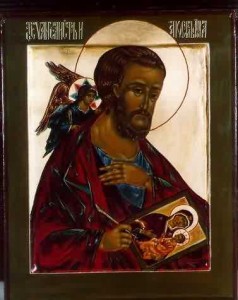Skip to content
St.Lukem evangelist.
* Antioch, today Antakya, Turkey(?)
† around 80 Thebes, today Thiva, Greece, or Bithynia, Turkey (?), or Achaia, Greece (?)
Meaning of the name: coming from Lucania (Gr.)
Attribute: bull
Patron Saint of Doctors

St. Luke, Russian icon
St. Luke, the evangelist, was probably born in the Syrian city of Antioch. It was a rich city with an excellent location, but at the same time, it was pagan. Lukáš’s parents were also rich pagans. They let him study because he had great talent. He became a doctor and traveled a lot in Greece and Egypt. We do not know when and in what way he converted to Christianity. Maybe it was St. Paul, who caught him with his sermons in Antioch. St. Luke then accompanied Paul on his apostolic journeys. In the year 51 he went with him and other disciples ( Timothy and Silas) to Philippe, Thessaloniki, Macedonia, and subsequently to Greece, Asia Minor, Palestine, Syria, and Italy. He was the only one who stayed with him even in Rome in prison and was with Paul even before his death, as Paul himself writes: “…only Luke is with me.”
Apparently, at Paul’s instigation, Luke wrote a description of the life and activities of the Lord Jesus, that is, the Gospel. St. told him about many events. Paul, but the holy fathers write that he was a close friend of the apostle St. John and the Virgin Mary, and he also knew other apostles. So he had enough sources to reliably capture the performance of Jesus Christ. He dedicated his gospel to the noble Theophilus. He probably wrote it after the fall of Jerusalem, between 80 and 90 in Greek. Likewise, he addressed it to Christians who had converted from paganism. This is also evidenced by the fact that in the Gospel he always tries to explain Jewish customs in detail. In his gospel, he is the only one of the evangelists to provide a detailed description of the birth of the Messiah. He writes very nicely about God’s mercy (the parable of the prodigal son, the good shepherd, the good Samaritan, Mary Magdalene, the penitent later). He begins his gospel with Zechariah’s sacrifice in the temple, which is why the bull became his symbol.
The Acts of the Apostles also come from the pen of this brilliant writer. He also dedicates them to Theophilus, for whom he also wrote the Gospel. The aim of this second book was for him to bear witness to a living Church that did not perish, despite the heathen world raging around. It describes the ascension of the Lord, and the sending of the Holy Spirit, and the book deals mainly with the work of St. Peter and St. Paul.
According to tradition, after Paul’s death (67), Luke preached the gospel in Dalmatia, Italy, and Gaul. Some state that it also reached Upper Egypt and Libya. How he died is not certain. Some say he was hanged in Patras, Greece at the age of eighty-four. But others say he died of natural causes.
It is common among Christians that he was also a painter and painted a picture of the Virgin Mary. Some paintings in the East are even attributed to him. However, it is not likely. He certainly painted a spiritual picture of the Virgin Mary in his Gospel, since he wrote about her the most of all the Evangelists. It is also uncertain where his grave is located, although many places claim ownership of it. Scientific research from 1998 says that the place of his grave could be the Basilica of St. Justin in Padua (Italy).
Visitors counter: 89
This entry was posted in
Nezaradené. Bookmark the
permalink.


Hello. And Bye.